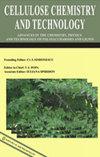马黛茶棒制备的纤维素纳米纤维:形态、化学和热性能的研究
IF 1.1
4区 农林科学
Q2 MATERIALS SCIENCE, PAPER & WOOD
Cellulose Chemistry and Technology
Pub Date : 2023-09-29
DOI:10.35812/cellulosechemtechnol.2023.57.65
引用次数: 1
摘要
研究了从马黛茶渣中提取纤维素纳米纤维的不同工艺条件。这包括化学(漂白和/或tempo氧化),物理(蒸汽爆炸)和机械处理(超细研磨)。透射电子显微镜(TEM)的形态学分析表明,所有处理都能有效地获得CNFs。从傅里叶变换红外光谱(FTIR)结果观察到,在所有处理后,半纤维素减少,纤维素含量增加。经过物理/化学/机械处理的马黛茶样品在333°C处表现出较高的热降解温度峰值,降解率为初始质量的50%。当对所有样品使用导数Friedman方法获得CNFs时,活化能(Ea)由33%提高到64%,且该方法与实验结果更接近。这些结果表明,CNFs可以从马黛茶残渣中获得,以使这种木质纤维素生物质增值。本文章由计算机程序翻译,如有差异,请以英文原文为准。
CELLULOSE NANOFIBER FROM YERBA MATE STICKS: SURVEY OF MORPHOLOGICAL, CHEMICAL AND THERMAL PROPERTIES
This study aims to evaluate different process conditions for obtaining cellulose nanofibers (CNFs) from yerba mate residues. This includes chemical (bleaching and/or TEMPO-oxidation), physical (steam explosion), and mechanical treatments (ultrafine grinding). All treatments demonstrated to be efficient in obtaining CNFs, as observed from a morphological analysis by transmission electronic microscopy (TEM). A reduction of hemicelluloses and an increase in cellulose content was observed from the Fourier-transform infrared spectroscopy (FTIR) results, after all the treatments. The yerba mate sample that underwent physical/chemical/mechanical treatments showed a higher thermal degradation temperature peak at 333 °C, with a degradation of 50% of the initial mass. The activation energy (Ea) increased from 33% to 64%, when the CNFs were obtained using the derivative Friedman method for all the samples, and this method presented a greater proximity to the experimental results. These results demonstrate that CNFs can be obtained from yerba mate residues, to valorize this lignocellulosic biomass.
求助全文
通过发布文献求助,成功后即可免费获取论文全文。
去求助
来源期刊

Cellulose Chemistry and Technology
工程技术-材料科学:纸与木材
CiteScore
2.30
自引率
23.10%
发文量
81
审稿时长
7.3 months
期刊介绍:
Cellulose Chemistry and Technology covers the study and exploitation of the industrial applications of carbohydrate polymers in areas such as food, textiles, paper, wood, adhesives, pharmaceuticals, oil field applications and industrial chemistry.
Topics include:
• studies of structure and properties
• biological and industrial development
• analytical methods
• chemical and microbiological modifications
• interactions with other materials
 求助内容:
求助内容: 应助结果提醒方式:
应助结果提醒方式:


